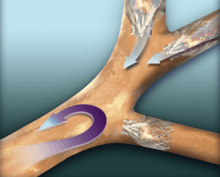Endobronchial valve
An endobronchial valve (EBV), is an implantable medical device—a small, one-way valve, which is implanted in an airway in the pulmonary system to treat one of several lung conditions. Endobronchial valves are typically implanted using a flexible delivery catheter advanced through a bronchoscope, and thus they are minimally invasive. The valves are also removable if they are not working properly.

Mechanism
The one-way endobronchial valve is typically implanted such that when a patient exhales, air is able to flow through the valve and out of the lung compartment that is fed by that airway, but when the patient inhales, the valve closes and blocks air from entering that lung compartment. Thus, an implanted endobronchial valve typically helps a lung compartment to empty itself of air. This has been shown to be beneficial in the treatment of emphysema, where lungs lose their elasticity and thus cannot contract sufficiently to exhale air, leading to air trapping and hyperinflation. When one or more diseased portions of an emphysematous lung are made to deflate and collapse, other healthier portions of the lung have more room in the chest cavity to inhale and exhale, pressure is removed from the diaphragm, and even the heart may function better as the hyper-inflated lung becomes smaller.[1] The amount of residual volume reduction achieved, correlates with the effects on FEV1, quality of life and exercise capacity.[2] Endobronchial valves have also been shown to be beneficial in treatment of persistent air leaks in the lungs. It has also been theorized that endobronchial valves may be useful for treatment of tuberculosis and its complications. Endobronchial valves may be the first successful medical device treatment of emphysema, a disease that affects billions of patients worldwide and has no known cure, being managed traditionally by lung transplantation and/or lung volume reduction surgery (though some patients do not meet the eligibility requirements for one or both of these invasive procedures).[3][4]
History
Endobronchial valves were developed primarily by the start-up medical device company Emphasys Medical (now Pulmonx - Redwood City, California) as a minimally invasive alternative to lung volume reduction surgery for emphysema. In lung volume reduction surgery, a surgeon cuts into a patient's chest and cuts out one or more diseased portion(s) of a lung. Endobronchial valves were designed to replicate the effects of that procedure without requiring incisions, by simply allowing the most diseased portions of the lung to collapse. Emphasys was purchased by Pulmonx in 2009, and Pulmonx currently markets the Zephyr® endobronchial valve (developed by Emphasys) in Europe, Australia, China and many other locations outside the U.S. Pulmonx also sells the Chartis® Pulmonary Assessment System, which is a patient assessment tool used with endobronchial valves to help physicians target appropriate lung compartments for treatment.[5] Another company, Spiration (Seattle, Washington), developed a different type of endobronchial valve and was acquired by Olympus in 2010.
References
- Ingenito, Edward P.; Tsai, Larry W. (2008). "Bronchoscopic Lung Volume Reduction". Thoracic Endoscopy: Advances in Interventional Pulmonology. pp. 188–197. doi:10.1002/9780470755969.ch12. ISBN 978-0-470-75596-9.
- Van Geffen, Wouter H.; Slebos, Dirk-Jan; Herth, Felix J.; Kemp, Samuel V.; Weder, Walter; Shah, Pallav L. (2019). "Surgical and endoscopic interventions that reduce lung volume for emphysema: A systemic review and meta-analysis". The Lancet Respiratory Medicine. 7 (4): 313–324. doi:10.1016/S2213-2600(18)30431-4. PMID 30744937.
- "Clinical Trial Examines Use of Valve for Treating Severe Emphysema" (Press release). Spiration. July 9, 2013. Retrieved February 16, 2019.
- Van Geffen, Wouter H.; Kerstjens, Huib A.M.; Slebos, Dirk-Jan (2017). "Emerging bronchoscopic treatments for chronic obstructive pulmonary disease". Pharmacology & Therapeutics. 179: 96–101. doi:10.1016/j.pharmthera.2017.05.007. PMID 28527920.
- Van Geffen, Wouter H.; Slebos, Dirk-Jan; Herth, Felix J.; Kemp, Samuel V.; Weder, Walter; Shah, Pallav L. (2019). "Surgical and endoscopic interventions that reduce lung volume for emphysema: A systemic review and meta-analysis". The Lancet Respiratory Medicine. 7 (4): 313–324. doi:10.1016/s2213-2600(18)30431-4. PMID 30744937.
Further reading
- Corbetta, Lorenzo; Montinaro, Flavio; Rogasi, Pier Giorgio; Luppi, Fabrizio; Magni, Chiara; Paiano, Simona; Tofani, Ariela; Pistolesi, Massimo (2013). "Improvement in tubercular cavities following adjuvant treatment with endobronchial valves: A case report [Correspondence]". The International Journal of Tuberculosis and Lung Disease. 17 (6): 850–851. doi:10.5588/ijtld.12.0992. PMID 23676177.
External links